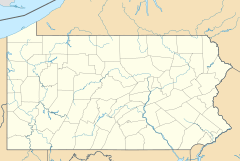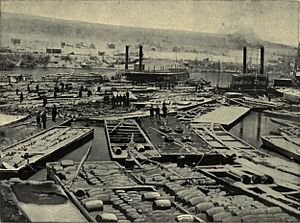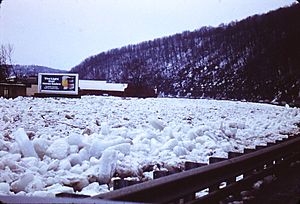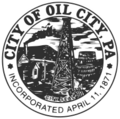Oil City, Pennsylvania facts for kids
Quick facts for kids
Oil City, Pennsylvania
|
|||
|---|---|---|---|
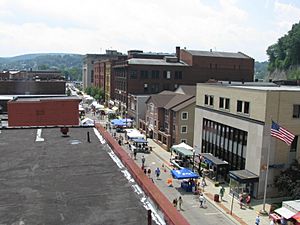 |
|||
|
|||
| Motto(s):
"A Special Blend of People"
|
|||

Location of Oil City in Venango County, Pennsylvania (left) and of Venango County in Pennsylvania (right)
|
|||
| Country | United States | ||
| State | Pennsylvania | ||
| County | Venango | ||
| Settled | 1824 | ||
| Incorporated (Borough) | 1862 | ||
| Incorporated (City) | 1871 | ||
| Government | |||
| • Type | Council/Manager | ||
| Area | |||
| • Total | 4.84 sq mi (12.53 km2) | ||
| • Land | 4.49 sq mi (11.64 km2) | ||
| • Water | 0.34 sq mi (0.89 km2) | ||
| Population
(2020)
|
|||
| • Total | 9,613 | ||
| • Density | 2,139.55/sq mi (826.17/km2) | ||
| Time zone | UTC-5 (Eastern (EST)) | ||
| • Summer (DST) | UTC-4 (EDT) | ||
| ZIP Code |
16301
|
||
| Area code(s) | 582; 814 | ||
| FIPS code | 42-56456 | ||
| Website | www.oilcity.org | ||
Oil City is the largest city in Venango County, Pennsylvania, United States. It's famous for its important role in the early days of the petroleum industry. The city is located where the Allegheny River bends, right at the mouth of Oil Creek. In 2020, about 9,608 people lived there. Oil City is the main city in the Oil City micropolitan area.
Oil City was first settled in small parts, mainly because of the iron industry. After the first oil wells were drilled in 1861, the city became a major center for the oil business. Big oil companies like Pennzoil, Quaker State, and Wolf's Head once had their main offices here. Today, tourism is a big part of the area's economy. Visitors come to see historic oil sites, enjoy nature trails, and admire the beautiful Victorian architecture.
Contents
History of Oil City
Early Settlements and Iron Industry
In 1796, the state of Pennsylvania gave land to Cornplanter, a chief of the Seneca nation. This land included a small area on both sides of the mouth of Oil Creek. The first white settler in the area that became Oil City was Francis Halyday, who bought land in 1803. His son, James Halyday, was the first white child known to be born here in 1809.
Later, in 1824, a company called William Kinnear & Co. built an iron factory, a foundry, a gristmill, and warehouses. This settlement was called Oil Creek Furnace. They used water power from a mill race to run the furnace. Homes were built for workers, and a steamboat landing was made on the Allegheny River.
The iron business didn't last long because the local iron ore wasn't very good. The furnace closed in 1849, and most people left the settlement. Only a few families, like the Bannons and Halydays, stayed behind.
From Deserted Village to Busy Landing
Even though Oil Creek Furnace was mostly empty, the area around it was still useful. The bend in the Allegheny River made it easy for barges and rafts to land. The remaining families rented rooms and barn space to the boatmen.
Around 1852, Thomas Moran built a large inn called Moran House, which became very popular. Other inns and a general store soon opened. A saloon called the Red Lion also started, offering entertainment. More land was sold and settled, leading to more people moving into the area.
The Oil Boom Begins
A major change happened when Edwin L. Drake drilled the first successful oil well in nearby Titusville in 1859. Soon after, oil was found south of the river in April 1861. Before this, fewer than six families lived in Oil City. The discovery of oil changed everything!
By 1868, many new towns, called boomtowns, grew quickly in the region, including Oil City. The oil trade became the most important business. Workshops were built to make parts for oil pipes, and warehouses stored oil. Barges carried oil down Oil Creek to Oil City, where it was then moved to larger steamboats or barges to go to Pittsburgh and other places.
Different parts of the growing area had different names. William L. Lay started a ferry and named his settlement Laytonia. Other areas were called Cottage Hill and Imperial City. Charles Lee also started a settlement called Leetown.
Uniting as Oil City
In 1862, the people living north of the river officially formed a borough and named it Oil City. South of the river, the growth was a bit messy, with streets not always lining up. To fix this, the people south of the river asked a judge to give their area a common name. In 1866, it was named Venango City. By this time, Venango City had over 1,500 people, and Oil City had over 4,500.
The people of both Oil City and Venango City soon realized it would be better to join together. On March 3, 1871, the state allowed them to combine into one city, keeping the name Oil City. The first mayor, William M. Williams, and the city council were sworn in on April 11, making it an official city. A city hall was built later that year.
Oil City's Growth and Challenges
Oil City faced many challenges, including floods in 1865 and 1866. In 1892, a major disaster struck when lightning hit oil tanks, causing burning oil to flow into the city. About 60 people died, and property worth over $1 million was destroyed.
Despite these challenges, Oil City grew into a busy community through the late 1800s and early 1900s. While some major oil companies later moved their headquarters, some oil wells in the area still produce good quality petroleum today.
Local governments and groups now work to promote tourism. They teach people about the city's rich oil history. Oil City's location by the Allegheny River, surrounded by the Appalachian Mountains, offers great chances to explore the beautiful nature of Northwestern Pennsylvania.
Several historic places in Oil City are listed on the National Register of Historic Places. These include the Oil City Downtown Commercial Historic District, the Oil City North Side Historic District, the Oil City South Side Historic District, the National Transit Building, and the Oil City Armory.
Geography and Environment
Oil City, Pennsylvania, is located where the Allegheny River meets Oil Creek. The city covers about 4.7 square miles (12.2 square kilometers), with most of it being land and a small part being water.
You can see many layers of rock and soil, some with fossils, on the bluffs around Oil City. The city is surrounded by hills, and the Allegheny River flows right through its downtown area.
Sometimes, the Allegheny River and Oil Creek freeze in winter, which can cause ice jams. These are like blockages of ice that can lead to flooding. The U.S. Army Corps of Engineers has built structures to help reduce ice formation and prevent floods. However, flooding can still happen at any time of year due to ice jams, heavy snowmelt, big storms, or even the remains of hurricanes.
Population and People
| Historical population | |||
|---|---|---|---|
| Census | Pop. | %± | |
| 1870 | 2,276 | — | |
| 1880 | 7,315 | 221.4% | |
| 1890 | 10,932 | 49.4% | |
| 1900 | 13,264 | 21.3% | |
| 1910 | 15,657 | 18.0% | |
| 1920 | 21,274 | 35.9% | |
| 1930 | 22,075 | 3.8% | |
| 1940 | 20,379 | −7.7% | |
| 1950 | 19,581 | −3.9% | |
| 1960 | 17,692 | −9.6% | |
| 1970 | 15,033 | −15.0% | |
| 1980 | 13,881 | −7.7% | |
| 1990 | 11,949 | −13.9% | |
| 2000 | 11,504 | −3.7% | |
| 2010 | 10,557 | −8.2% | |
| 2020 | 9,608 | −9.0% | |
| 2023 (est.) | 9,374 | −11.2% | |
| Sources: | |||
As of 2018, Oil City had about 9,749 people living there. Most of the people (about 94.3%) are White. There are also smaller groups of African American, Asian, and Native American residents. About 0.63% of the population is Hispanic or Latino.
About 25.8% of the people in Oil City are under 18 years old. The average age in the city is 38 years. For every 100 females, there are about 90.6 males.
Things to See and Do
Oil City offers several attractions for visitors:
- Oil Creek State Park: A beautiful park with trails and natural scenery.
- Indian God Rock: A large rock with ancient carvings.
- Oil City Armory: A historic building.
- Oil City Northside: An area with many historic buildings.
- Oil City Southside: Another historic district with interesting architecture.
Local Media
Oil City has its own local media. WKQW 1120 AM and 96.3 FM are the only locally owned radio stations in Venango County. The Derrick Publishing Company, also locally owned, publishes a general interest newspaper six days a week.
Sports Teams
Oil City has a history with Minor League Baseball teams. The Oil City Oilers played from 1940 to 1951. They were first connected with the Pittsburgh Pirates and later with the Chicago White Sox. In 1947, their name changed to the Oil City Refiners. In 1951, they became the Oil City A's before the team and league ended.
The "Oilers" name was also used by earlier teams in 1895 and 1898. Another team, the Oil City Cubs, played from 1906 to 1908.
Famous Baseball Players from Oil City Teams
Several notable players were part of Oil City's baseball teams:
- Otto Denning
- Mike Garbark
- Al Gionfriddo
- Elmer Klumpp
- Junior Walsh
- Hal Woodeshick
- Rudy York
Notable People from Oil City
Many interesting people have come from Oil City:
- Charles Almanzo Babcock: He created Bird Day, first celebrated in Oil City schools in 1894.
- George Carpenter: A skilled fighter ace during World War II.
- William Holmes Crosby, Jr.: One of the people who helped start the study of hematology (blood diseases).
- Francis "Gabby" Gabreski: A famous fighter ace in both World War II and the Korean War. He was one of only seven US pilots to be an ace in both wars and the leading US ace in Europe with 28 confirmed kills.
- Woody Jackson: A composer and producer known for video game music.
- Joseph Levi: A Pennsylvania state politician and businessman.
- Ben Koyack: An NFL player from 2015 to 2019.
- Josephine McKim: An Olympic gold medal-winning swimmer in 1932.
- Dusty Miller: An MLB player in the 1890s.
- Major General George C. Rickards: The Chief of the Militia Bureau (now National Guard Bureau) in the 1920s.
- W.S. Borland: A sports coach.
- Virgil Tupper: A football player.
- Ronald Black: A politician.
- Scott Hutchinson: A politician.
- Chris Kirkpatrick: A singer for the famous group NSYNC.
Images for kids
-
Location of Oil City in Venango County, Pennsylvania (left) and of Venango County in Pennsylvania (right)
See also
 In Spanish: Oil City (condado de Venango) para niños
In Spanish: Oil City (condado de Venango) para niños




